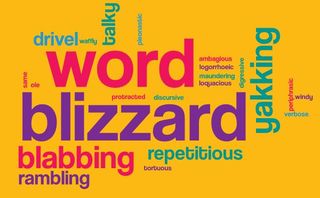Introversion
Word Blizzards at Meetings: 7 Ways to Plow Through Them
Introverts: Use these tips to navigate your next boisterous business meeting.
Posted December 30, 2019 Reviewed by Davia Sills

Most people are too wordy for me. If you’re an introvert who, like me, spends more time listening than speaking, you may be a magnet for yakkers who utter way over the daily average of 16,000 words a day.
If so, you’re a captive audience at many a business meeting and social event—not to mention holiday gatherings. So brace yourself for word blizzards.
Say you’re in a meeting, and you want to contribute. But as others drone on, your mind wanders to thoughts of the linguini you’ll have for lunch. To make matters worse, if you’re an introvert, it may take the entire meeting to formulate a point you’d like to make—about something important, like raising your organization’s revenues. You don’t like to interrupt (or, the even gentler reframing I suggest: interjecting). Then the meeting ends, and you never get to make that point. What a loss for all parties.
Use these tips to prepare for the next word blizzard you’ll encounter—with special angles for introverts. The tips range from reminders of time-tested basics to novel techniques to try.
1. Make or obtain an agenda.
If you know that yakkers are going to attend a meeting, you can count on their yakking. So it’s best to prepare. That starts with an agenda—meeting 101 stuff, sure. Yet it amazes me how many meetings still go on without one.
If you’re the facilitator, do everyone a favor by outlining the point of your meetings and who will address what. The introverts attending will especially appreciate getting this advance notice. If you’re not the facilitator, ask them for an agenda in advance; that can entail a maximum amount of time that each person gets to speak about a given topic, which can help prevent yammering. Everyone will benefit.

2. Prepare your key points beforehand.
Think of the most important ideas you want to convey—and possibly circulate them in advance. After all, many of the best meetings are preceded by “pre-meetings,” which can be one-on-one discussions as well as e-mail or text exchanges. So by the time the main meeting occurs, you’ve gotten to socialize your ideas, influence others, and get their input. All of that is especially valuable to introverts, who do best taking the time to formulate their ideas, rather than articulating them on the spot.
3. Use ground rules.
Whether you go with the formality of Robert’s Rules of Order or just pick a few key guidelines to structure your meetings, ground rules contribute to productive exchanges. They can include sticking to an agenda, “Vegas rules” (i.e., nothing gets repeated outside the meeting), offering praise publicly, but constructive feedback privately, and starting as well as ending on time. Another ground rule can be setting time limits for each person to speak about a given topic, which can prevent yammering.
What do you do when someone goes over their time? I like the idea of lining up a process observer, in advance, whose role is to enforce the rules. Doing so can support a respectful meeting. Speaking of which, another introvert-friendly ground rule can be to ensure that everyone gets a chance to speak before anyone speaks a second time.
4. Pass a talking stick.
How do you get a word in edgewise during a boisterous meeting? A novel technique U.S. Senator Susan Collins has used successfully among bipartisan colleagues is a talking stick—only the person holding it gets to speak. A technique with West African as well as Native American origins, it is a nifty way to prevent overtalk.

5. Try a standing meeting.
I’ve only attended a handful of standing meetings—usually one-on-one speed walks with colleagues or bosses on our way somewhere. Yet the idea of a standing meeting makes sense if only to keep it short. Although, conceivably, one person could pontificate while the others look on. Hence the advantages of ground rules whenever possible.
6. Try “brainwriting.”
Northwestern Kellogg School of Management Professor Leigh Thompson says that during a typical six-person meeting, two people do more than 60 percent of the talking—and with more people, the problem gets worse. She uses an innovative approach called “brainwriting,” which entails meeting silently for 10 minutes while all participants write down their ideas anonymously. Then everyone votes on the ideas. That strikes me as an introvert-friendly approach to brainstorming.
Thompson describes success using this technique in organizations. Conversely, she says that taking the chatty people aside to give them feedback about their chattiness doesn’t help, since they’re often not self-aware.

7. Avoid meeting.
If addressing an issue by e-mail, instant messaging, or text exchanges would do the trick, don’t meet (says the introvert!). If you need to meet, be purposeful about whom you invite to a meeting. This might sound delicate, but if you know someone is likely to slow down your meetings with unnecessary chatter, and they’re not open to feedback about it, try meeting without them.
Use these techniques, and you’ll get to make your point about raising revenues and even get to that lovely linguini lunch a bit sooner. If you want to learn more, check out my related stories, “Morph into a Business Meeting Ninja—Parts 1 and 2” and “Introverts' Guide to Holiday Merriment.”
Copyright © 2019 Nancy Ancowitz
References
Economy, P. (2019, January 11). A New Study of 19 Million Meetings Reveals That Meetings Waste More Time Than Ever (but There Is a Solution). Retrieved December 26, 2019, from https://www.inc.com/peter-economy/a-new-study-of-19000000-meetings-reve….
Mehl, M. R., Vazire, S., Ramírez-Esparza, N., Slatcher, R. B., & Pennebaker, J. W. (2007, July 6). Are Women Really More Talkative Than Men? Retrieved December 12, 2019, from https://science.sciencemag.org/content/317/5834/82.full.
The Story of the Talking Stick. (n.d.). Retrieved December 26, 2019, from https://www.educatorsforpeacefulclassroomsandcommunities.org/resources/….
Video: How brainwriting can neutralize the loudmouths. (n.d.). Retrieved December 26, 2019, from https://www.kellogg.northwestern.edu/news_articles/2014/06262014-video-….




